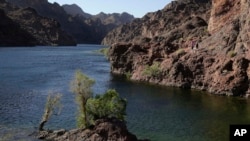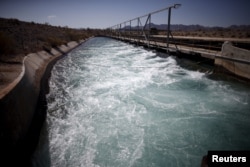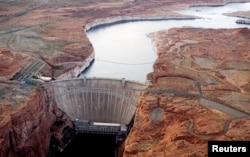The United States and Mexico have agreed to renew and expand a far-reaching conservation agreement that governs how they manage the overused Colorado River, which supplies water to millions of people and farms in both nations.
The agreement to be signed Wednesday calls for the U.S. to invest $31.5 million in conservation improvements in Mexico's water infrastructure to reduce losses to leaks and other problems, according to officials of U.S. water districts who have seen summaries of the agreement.
The water that the improvements save would be shared by users in both nations and by environmental restoration projects
The deal also calls on Mexico to develop specific plans for reducing consumption if the river runs too low to supply everyone's needs, said Bill Hasencamp of the Metropolitan Water District of Southern California, which supplies water to about 19 million people in and around Los Angeles.
Major river consumers in the U.S. would be required to agree on their own shortage plan before Mexico produces one, he said.
The deal will extend a previous agreement that both countries would share the burden of water supply cutbacks if the river runs low, Hasencamp said.
The International Boundary and Water Commission, which has members from both countries and oversees U.S.-Mexico treaties on borders and rivers, declined to release a copy of the agreement before Wednesday's signing ceremony in Santa Fe, New Mexico.
Officials with the Mexican foreign ministry said in an email Tuesday they had no immediate comment, but U.S. officials who have been briefed on the details said the deal will help both sides.
"It's good news for both nations, for water users in the U.S. and Mexico,'' said Chuck Collum of the Central Arizona Project, another Colorado River user that will help fund the infrastructure improvements in Mexico.
The agreement provides more certainty in how the two countries will deal with the risk of a shortage and recognizes the danger the river faces, he said.
"It's an acknowledgement that the U.S. and Mexico both share risk due to a hotter and drier future,'' Collum said.
The Colorado River is in the midst of a prolonged regional drought, and some climate scientists have said global warming is already reducing the amount of water it carries.
A study published in February by researchers from the University of Arizona and Colorado State University said climate change could cut the river's flow by one-third by the end of the century.
The river begins in the mountains of Colorado and winds 1,400 miles (2,250 kilometers) to Mexico, although heavy use means it usually dries up before it reaches its delta on the Gulf of California where Mexico's Sonora and Baja California states meet.
Along the way, it supplies water to about 40 million people and 6,300 square miles (16,300 square kilometers) of farmland in the United States alone. Equivalent figures for Mexico weren't immediately available.
The deal being signed Wednesday, known as Minute 323, is an amendment to a 1944 U.S.-Mexico treaty that lays out how the two nations share the river. The treaty promises Mexico 1.5 million acre-feet (1.9 billion cubic meters) of water annually.
The U.S. uses the rest. The average annual flow in the river is about 16.4 million acre-feet (20 billion cubic meters), according the U.S. Bureau of Reclamation, which manages the river in the United States.
One acre-foot (1,200 cubic meters) is enough to supply a typical U.S. family for a year.
The new agreement, which will be in force for nine years, does not include a repeat of the historic 2014 "pulse'' that sent about 105,000 acre-feet (130 million cubic meters) of water surging into river's delta in Mexico, the U.S. water officials said.
That was an environmental experiment that brought water and life to the dried-out delta for the first time in years.
But the agreement does include up to 210,000 acre-feet (260 million cubic meters) for environmental restoration projects, according to a briefing from Southern California's Imperial Irrigation District, one of the funders of the Mexican infrastructure projects.
Details of those projects were not immediately available.








